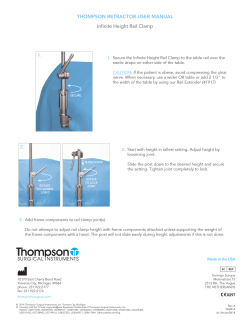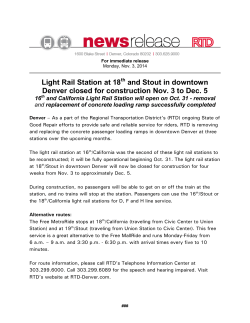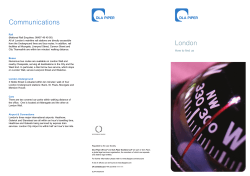
Transloading Crude on Rail Tank Cars
Why Best Practice Development is Important A major event at one transload facility could have significant regulatory or financial impact on others due to increased regulations if industry does not have defensible, well defined practices. Crude by Rail: The Regulatory System Crude oil can be transported by rail provided the following are in place: The product is properly classified and degree of hazard known (crude) The selected package is properly manufactured for the product being transported (rail car) Railroads follow carrier rules, and emergency response plans and hazard communications are in place. (transportation) The rail tank car is properly maintained and operated (operations and maintenance). This last statement is where the transloader has the responsibility and control. Crude by Rail: The Regulatory System EMERGENCY RESPONSE Transport Accident Response/Support –ERAP Hazard Communications – MSDS/Waybill TRANSPORT Determine Hazard Class and Group DETERMINE TRANSPORT QUANTITY SELECT AND MAINTAIN PACKAGE (REUSE) Packing Group 1 Bulk Packages for High Hazard Liquids Rail Car Class DOT 103, 104, 105, 111, 112, 114, 115 or 120 fusion welded car tanks; and Class 106 or 110 multi-unit tank cars LOAD UNLOAD SITE SAFETY AND EMERGENCY RESPONSE On site accident response – RP Hazard Communications – MSDS Personnel Safety Rules Environmental Rules OPERATOR REQUIREMENTS Product Testing Packing Group II Bulk Packages for Medium Hazard Liquids Rail Car Class DOT 103, 104, 105, 109, 111, 112, 114, 115 or 120 fusion welded car tanks; and Class 106 or 110 multi-unit tank cars and AAR Class 206W tank cars PACKAGE DESIGN Specifications for Tank Cars PACKAGE MAINTENANCE Rules for Tank Car Repair and Modification AAR Pamphlet 34 §173.10 Tank car shipments. §173.24 General requirements for packagings and packages. §173.24b Additional general requirements for bulk packagings. §173.29 Empty packagings. §173.30 Loading and unloading of transport vehicles. §173.31 Use of tank cars. §174.67 Tank car unloading. Non-regulatory Groups Involved in the System Product: Classification and PG Determination – COQA (US)/CCQTA(Canada). API. ASTM. ANSI. Package: Rail Cars – AAR (US/Canada). API. Emergency Response – Recently API and TRANSCAER partnered with the Federal Railroad Administration Loading and Unloading Operations – API (RP3000). BOE/AAR. Transportation – AAR, RAC (Canada) Is there still a gap in Operations Focus? Still a gap to fill? Simple answer is yes. (not implying wrong actions being taken) No formal group focused on all aspects of operations. BOE/AAR Pamphlet 34 is generally referenced and used but does not include all the how, only the what. i.e. tool tight. API RP3000 focuses only on crude testing and overfill Current guidance documents are not mandatory and do not always give best practices. Ex: rail car checklists, torqueing of manway covers, grounding. What will Best Practices Focus Fulfill? Close void in agreed upon “Best Practices” for transloading operations. Close potential gap in current written guidance. Provide governments and populations the assurance local tranlsoad sites operations are safe. Provide other transload sites and carriers assurance rail cars are being operated correctly at each (and potentially multiple) touch point and legal requirements are effectively being met each time. Provide rail car lessors assurance rail tank cars are being appropriately treated as engineered vessels, applying the same care to operate and maintain them. Recommendation to determine Best Practices Bring focus in this areas by developing a crude oil transloader forum, or use an existing organization, to: define how best practices are developed, disseminated, and maintained. develop Communication tool to be used between transloaders to inform them of potential shortfalls in operations. Lessons learned/event review process to alert transloaders of potential issues and update practices. Conference type forums for transloaders to discuss progress and communicate best practices. Example Best Practices Use of common loading checklists and training in inspection techniques. Standard rail car acceptance criteria. Use of torque wrenches for manway covers or better defining what does “tool tight” mean and how to apply the definition in practice De-icing the BOV on a non-insulted rail car. Steaming and removal of product from a coiled and insulated rail car. Determining car external cleanliness Determining water content in heavy crude loads Determining the correct car is loaded/unloaded Determining the previous product remaining in a rail car Questions/Discussion
© Copyright 2025










